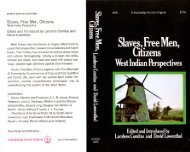e - CIFAS
e - CIFAS
e - CIFAS
You also want an ePaper? Increase the reach of your titles
YUMPU automatically turns print PDFs into web optimized ePapers that Google loves.
vi PREFACE CONTENTS vii<br />
however, we differ from the historians in certain important ways.<br />
The two theoretical chapters and the general organization of this<br />
study illustrate my view ofan anthropological approach to history,<br />
and the accountofthe growth of this bookshows how this approach<br />
and the theories associated with it have developed.<br />
To Professor Daryll Forde lowe far more than Tcan acknowledge<br />
for his tireless interest and careful criticism of all the drafts<br />
of this book. He has always insisted on clarification and fullness of<br />
detail, and even when disagreeing with my interpretations, has<br />
given generous constructive criticism. It is not too much to say<br />
that withont his interest the manuscript might not have got much<br />
further than the first draft.<br />
Dr. Esther Goldfrank and her husband, Professor Karl A.<br />
Wittfogel, have also criticized the manuscript at different stages,<br />
and I have drawn much encouragement from their stimulating<br />
comments.<br />
To Mallam Hassan and hi8 brother MaUam Shu'aibu, whose<br />
books on the Habe of Abuja initially made this endeavour p088ible,<br />
lowe the warmest appreciation and thanks. Mallam HaSBan taught<br />
me Hausa at the School of Oriental and Mclean Studies, and I had<br />
the good fortune to meet Mallam Shu'aibu in Katsina Province,<br />
Nigeria, where he was Provincial Education Officer, in February<br />
1959. We discussed his text in detail, and he gladly answered<br />
certain critical questions about the pattetn8 of recruitment to<br />
Abuja offices which my further experience in Nigeria had raised.<br />
A paragraph in the text summarizes this new information.<br />
My Fulani infonnants are too many to name individually. The<br />
chief of them were the Madaki Sa'idu, son of the Emir Aliyn, the<br />
Galadima Hayatu, the Mada.uci Ibrahim, the Fagaci Muhammadu,<br />
MaDam Abdulkadiri of Tukur-Tukur, and especially Mallam<br />
Ibrahim Mijiniya, who has since died. To these and all others who<br />
taught me the cultural significance of their history, I am most<br />
sincerely indebted. I also drew on District Notebooks and other<br />
administrative records.<br />
The fieldwork on which this study is based was carried out in<br />
1949-50 on a Fellowship of the Colonial Social Science Research<br />
Council. Since completing work on this manuscript, I have also<br />
had the opportunity to return to Northern Nigeria to carry out<br />
comparable studies of political history in the emirates of Kana,<br />
Katsina, Daura, and Sakata as a member of the staff of the<br />
Nigerian Institute of Social and Economic Research. I am most<br />
grateful to Professor R. H. Barback and the Institute for providing<br />
me with this opportunity. and to the University College of the<br />
West Indies for granting an extension of leave for this purpose. My<br />
object in returning to Northern Nigeria and studying the history<br />
of these states was simply to test those generalizations about the<br />
process of governmental change with which this book concludes<br />
against new bodies of data. For if, to the social anthropologist,<br />
history may permit or require theories of change, these theories<br />
must be stated explicitly and must be subject to comparative tests.<br />
M. G. SMITH.<br />
LoNDON, SeptembIT 1959.





